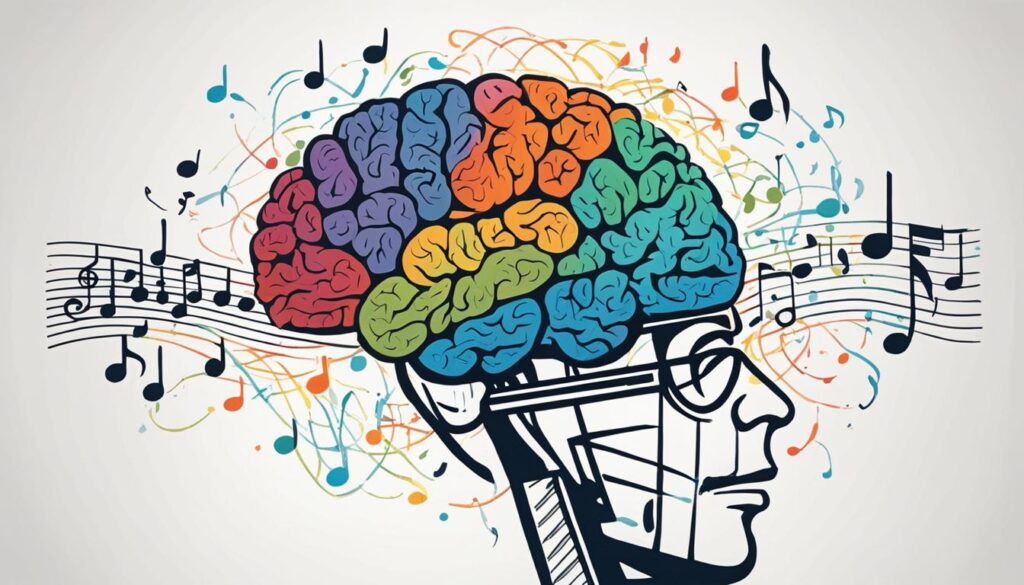Delving into the symphony of neurology and music, Oliver Sacks’ esteemed work, “Musicophilia: Tales of Music and the Brain,” orchestrates a fascinating journey through the neurological landscapes sculpted by melodies, rhythms, and harmonies. This book is not merely a collection of observations; it is a sonata that blends brain science and music psychology into a narrative that reverberates with the expressive depth of Sacks’ studious compositions.
Through the pages of “Musicophilia,” readers unfurl a tapestry of neurological wonders, each thread imbued with Sacks’ profound insights into the human psyche and its intricate relationship with music. With the “Musicophilia” audiobook, one’s exploration of these tales transcends the written word, offering an immersive auditory experience that unveils the music of our minds in a resoundingly intimate manner.
Each chapter, much like a movement in a grand concerto, reveals nuances of the profound connection between our cognitive functions and the universal language of music. Sacks’ books entice us to ponder life’s expansive score, where science and art converge to narrate the compelling story of humanity’s quintessentially musical nature.
Exploring Oliver Sacks’ Fascination with Music and the Mind
The noted neurologist Oliver Sacks held a deep fascination with the neurology of music, an interest that beautifully intersected with his professional life. This passion gave birth to the book Musicophilia, offering Musicophilia insights into how music impacts our brains and shapes our experiences. Sacks’ extensive research was not only academic but also personal, informing a body of work that has intrigued readers worldwide.
At the core of Sacks’ inquiry was his persistent quest to understand the music and mind connection. Driven by innate curiosity and professional expertise, Sacks delved deeply into the realm of music psychology. His investigation uncovered a rich array of insights, ranging from how music can invoke profound emotional responses to its power to unlock memories and rehabilitate cognitive functions.
In Musicophilia, we see Sacks exploring several key themes that draw connections between cognitive processes and musical experiences. Here are some thematic explorations from the book:
- The extraordinary range in which music is perceived and experienced among different individuals.
- Music’s power to elicit deep-seated memories, even in patients with severe amnesia.
- The phenomenon of ‘musical hallucinations’ and what it reveals about the brain’s neural network.
- Case studies of Sacks’ own patients who have unique neurological disorders tied to their experience of music.
- Personal anecdotes that allow a glimpse into how Sacks’ understanding of music also informed his self-awareness and personal development.
Oliver Sacks’ comprehensive approach towards studying the neurology of music bridges scientific inquiry with humanistic sensitivity, making Musicophilia not just a record of neurological anomalies but a celebration of the intrinsic role music plays in human life.
Decoding the Scientific and Humanistic Approach in “Musicophilia”
Oliver Sacks’ “Musicophilia” offers a unique exploration into how our brains engage with music, blending cognitive neuroscience with the art of storytelling. Sacks’ clinical observations converge with his compassionate narrative style, unraveling the complex tapestry of music’s influence on the human mind.
The Neuroscience of Music Appreciation
At the core of music and brain research is the understanding of how melodies and rhythms are processed by different neural pathways. Sacks’ work delves into how these auditory experiences can shape emotions, memories, and even identities, offering insights into the neurological underpinnings of music appreciation.
Oliver Sacks’ Fusion of Clinical Tales and Empathy
What sets Sacks apart is his capacity to humanize the science that he presents. Through a lens of empathy, he shares real patient stories, spotlighting how music can serve as a medium for healing and connection amidst neurological disorders. Sacks’ clinical observations not only reveal the science behind the brain’s response to music but also reflect the profound human experiences attached to it.
| Neurological Element | Role in Music Appreciation | Illustrated by Sacks’ Tales |
|---|---|---|
| Auditory Cortex | Processing of sound patterns | Patient with amusia’s struggle and recovery |
| Limbic System | Emotional responses to music | Stories of music triggering deep emotional memories |
| Motor Cortex | Rhythm and movement coordination | Observation of music’s ability to aid in motor rehabilitation |
| Corpus Callosum | Inter-hemispheric communication | Case of musicianship and inter-hemispheric collaboration |
How “Musicophilia” Mirrors the Complexity of the Human Brain
Oliver Sacks’ seminal work, “Musicophilia: Tales of Music and the Brain”, touches on the profound way music influences the human experience, acting as a lens through which we can view the intricacies of our own cognition. The book delves into thematic content that demonstrates a remarkable music and memory link, with music therapy at its centerpiece, backed by meticulous neurological case studies which lay bare the brain complexity in a manner that’s both engaging and enlightening.
Real-Life Stories of Music and Memory
Through vivid storytelling, Sacks expounds on the pivotal role music plays in shaping our memories and identity. His neurological explorations shed light on how a mere melody can evoke powerful recollections, tethering the past with the present. These memoirs of musical memories are more than stories; they represent a profound connection between auditory stimuli and our personal narratives.
The Role of Music in Neurological Conditions
The book also chronicles music’s role in the lives of patients grappling with various neurological conditions. Sacks’ work reveals remarkable instances where music therapy has led to significant improvements in conditions such as dementia, Parkinson’s disease, and brain injuries, underscoring its potential as a therapeutic modality. Each case study details the transformative power of music, providing hope that it can serve as a key to unlock even the most enigmatic aspects of the brain.
- Music as a mnemonic device in Alzheimer’s patients
- Stimulating movement in individuals with Parkinson’s via rhythm
- Easing the phantom limb pain through melodic intonations

In the annals of “Musicophilia”, Oliver Sacks has managed to transform medical case studies into a tapestry of anecdotes that reveal as much about the resilience of the human spirit as they do about the healing power of music. By intertwining the discipline of neuroscience with the artform of music, Sacks has provided a comprehensive look into one of the most profound links within ourselves—the boundless connection between music and the human brain.
| Condition | Impact of Music Therapy | Case Study Insights |
|---|---|---|
| Alzheimer’s Disease | Recall of past memories and emotions | Patients demonstrate recognition and emotional responses to familiar tunes |
| Parkinson’s Disease | Improved motor coordination and movement initiation | Rhythmic cues lead to enhanced walking abilities |
| Stroke Recovery | Assisted in language recovery and relearning speech | Melodic Intonation Therapy aids patients with aphasia |
| Epilepsy | Reduction in the frequency of seizures | Listening to certain frequencies helps in managing seizure activity |
Insights into ‘Earworms’ and Musical Hallucinations
Oliver Sacks’ “Musicophilia” delves deep into the quirks and intricacies of the human mind through the lens of music, especially focusing on those catchy tunes that seem to loop endlessly in our heads. Known as earworms or involuntary musical imagery (INMI), these snippets of melodies or rhythm invite a closer look into the cognitive processes that make them stick.
Unpacking the Phenomenon of Stuck Songs
The concept of earworms isn’t just about musical preferences; it’s about understanding why certain tunes latch onto our minds. From the ‘Happy Birthday’ song to the latest pop hit, certain characteristics make tunes more likely to be remembered and repeated internally. As detailed in “Musicophilia,” these memorable fragments of sound can act as a type of involuntary musical imagery, showcasing the powerful impact of musical memories on the neural pathways of our brains.
Understanding the Brain’s Jukebox
At the heart of these auditory experiences is what can be described as the brain’s internal jukebox, a figurative repository where certain musical phrases are queued up and played back, often without conscious control. This phenomenon is closely associated with auditory hallucinations, revealing the thin line between involuntary recall and perception without external stimulus. Sacks’ insights into the brain’s jukebox shed light on the repetitive nature of earworms and offer a fascinating perspective on how our brains organize and retrieve musical imagery.
| Features of Catchy Tunes | Association with INMI | Effect on Auditory Hallucinations |
|---|---|---|
| Repetitive melody | High repetition linked to involuntary retrieval | Potential to trigger recurrent hallucinatory episodes |
| Simplicity of rhythm | Simple patterns are easier to memorize and recall | Facilitates the sensation of hearing music without external input |
| Unexpected intervals or rhythms | Captures attention, increasing potential for INMI | May give rise to more vivid and persistent auditory experiences |
| Emotional connection | Strong emotions can solidify memory traces of music | Emotionally charged tunes are often at the core of musical hallucinations |
The Therapeutic Power of Music Showcased in “Musicophilia”
Oliver Sacks’ “Musicophilia” is a treasure trove of Sacks’ music stories that uncover the profound and often underrated music therapy benefits for mental and neurological health. Each chapter reveals a new layer of music’s healing effects through anecdotal evidence and scientific exploration. In witnessing the positive transformations music can incite, Sacks’ work becomes a compelling endorsement for music as a healing modality.
In the realm of music therapy, personal accounts become a powerful testament to the transformative potential of melodies and harmonies. The book delves not only into theoretical postulations but also presents vivid case studies where music plays the protagonist in stories of recovery and discovery.
“Music can lift us out of depression or move us to tears – it is a remedy, a tonic, orange juice for the ear. But for many of my neurological patients, music is even more – it can provide access, even when no medication can, to movement, to speech, to life. For them, music is not a luxury, but a necessity.” – Oliver Sacks in “Musicophilia”
| Condition | Music Therapy Role | Outcome in “Musicophilia” |
|---|---|---|
| Parkinson’s Disease | Rhythm and tempo facilitate movement | Enhanced motor control and gait improvement |
| Alzheimer’s Disease | Memory recall through familiar tunes | Rekindling of memories and temporary cognitive boosts |
| Depression | Emotional expression and processing | Improved mood and a sense of well-being |
| Autism Spectrum Disorders | Non-verbal communication and social engagement | Increased interaction with others and social connectivity |
The convergence of music and medicine forms the crux of “Musicophilia”, emphasizing that clinical treatment can indeed harmonize with the artistic expression of music for holistic healing. Sacks’ work inspires us to consider music not just as a source of entertainment but also as a powerful ally in the journey toward healing and well-being.
Oliver Sacks: Intersecting the Paths of a Neurologist and a Music Lover
Renowned for his extraordinary ability to communicate complex medical narratives, Oliver Sacks was a figure whose professional life was considerably shaped by his personal passions. Among those, his love for music stands out prominently, intricately connected with his neurological practice and insights. The convergence of Sacks’ professional expertise and his profound appreciation for music resulted in unique contributions to the understanding of human cognition and its relationship with music.
Biographical Elements in Sacks’ Writings
In “Musicophilia”, Oliver Sacks injected the richness of his own life into the scientific discourse. His biography is not merely a background story but a vivid canvas upon which the journey of a music lover intersects with the rigor of a scientist. Sacks’ narrative is replete with the kind of detailed storytelling that only someone with both a personal and a professional stake in music could deliver. These elements of his biography offer a gateway through which readers can understand the subject matter on a more intimate level.
Perspectives on Music from a Neurological Standpoint
Through the lens of a music lover, imbued with the knowledge of a seasoned neurologist, Sacks presented neurological insights that resonate with a wide audience. His perspective is unique; it comes not just from the clinical observation of a disease but from a deep understanding and empathy derived from personal experience. Sacks’ insights bridge the gap between the mechanics of the brain and the artistry of music, allowing a nuanced interpretation of how music can influence neurology and vice versa.

“Musicophilia”: Bridging the Gap Between Art and Science
The realm of neurology and art has often been seen as existing in parallel universes, where the methodical and analytical nature of science diverges from the free-formed creativity of art. However, Oliver Sacks’ “Musicophilia” shatters this conventional dichotomy, presenting a stirring example of interdisciplinary studies. Sacks, known for his ability to traverse diverse territories, masterfully bridges these purportedly disparate disciplines, crafting a narrative that both educates and inspires.
Throughout the book, Sacks encapsulates the essence of music’s profound effect on the human psyche, revealing the undeniable synergy between the neurological underpinnings of the brain and our innate responsiveness to art. This relationship is further emphasized by a pivotal notion that Sacks brings to light—the consideration that art, and specifically music within this context, is not merely a form of cultural expression but also a pivotal component of our cognitive fabric.
Oliver Sacks’ ardent inquiries and clinical insights offer an indelible impression of music’s capacity to influence, to heal, and to unveil the enigmatic workings of the human brain.
“In ‘Musicophilia,’ we find a dazzling record of how art intertwines with science, each enriching the other to narrate the story of human experiences in unparalleled ways,”
expresses a sentiment resonating with advocates of integrative cognitive studies.
- Case studies demonstrating the therapeutic influence of music on neurological disorders
- A myriad of personal anecdotes linking musical experiences with cognitive processes
- Evidence-based approaches establishing the principles of auditory perception and memory
It is this meticulous blending of Sacks bridging disciplines that grants us a comprehensive perspective on why works like “Musicophilia” are indispensable. They serve as linchpins in our broader understanding of ourselves, guiding us through a melodic journey of the mind that honors both the sciences and the humanities.
Audiobook Review: A New Dimension to “Musicophilia” by Oliver Sacks
Oliver Sacks’ “Musicophilia” is a celebrated exploration into the mysteries of music’s influence on the human brain. In its audiobook iteration, the narrative comes alive in a rich auditory experience that captivates the listener from start to finish. In this review, we delve into the facets that make the “Musicophilia” audiobook an exceptional format to absorb Sacks’ storytelling.
The transition from print to audio presents an unparalleled opportunity for readers—now listeners—to engage with the content in a mode that embodies the book’s core subject: listening. The audiobook format underscores the theories and emotions conveyed through Sacks’ words, with the added advantage of aural nuances that evoke the sensation of music discussed within.
At the helm of the narration is a voice that resonates with clarity and warmth, bringing Sacks’ case studies and insights to life. The pacing is deliberate—allowing the listener to ponder concepts and stories, and the adept use of pauses and cadence mimics the ebb and flow of a musical piece. This dynamic pace aligns seamlessly with the text, which alternates between technical explanations of brain phenomena and tender accounts of patients and their relationships with music.
Below, I share a personal perspective tapered with the particulars of the audiobook presentation:
Listening to Sacks recount tales of those so deeply affected by music—through a medium that is itself an auditory experience—added layers to my understanding and appreciation for his work. It’s as if the audiobook presents an environmental context, making the substance of ‘Musicophilia’ even more palpable.
To further illustrate the unique elements of this auditory journey, the following table highlights key aspects of the audiobook’s impact on the listener’s experience:
| Element of Audiobook | Impact on Experience |
|---|---|
| Narration | Enhances empathy and connection with the stories told |
| Pacing | Allows for reflection; mirrors the contemplative nature of the subject |
| Tone | Adds emotional depth, reinforcing the book’s humanistic side |
| Aural Quality | Directly engages the listener’s auditory faculties, strengthening the thematic link |
Overall, the “Musicophilia” audiobook not only serves its purpose as a means of consuming text but enhances the subject matter through its format. It is a testament to the celebration of the auditory experience, paralleled with Sacks’ masterful storytelling. It is a rendition that I would highly recommend to those looking to immerse themselves fully in the fusion of science, music, and the art of narrative.
Conclusion
As we reflect on the tapestry of tales and in-depth analysis presented in “Musicophilia,” we uncover the profound reasons that make this book essential reading. For anyone captivated by the harmonies of neurology and music, this work stands as a cornerstone of influential neuroscience literature, seamlessly intertwining science with the symphony of human experience. “Musicophilia” is not merely a book; it is an exploration of the melody that plays within us all, resonating through the chambers of the mind and the corridors of the heart.
Why “Musicophilia” is a Must-Read for Music and Science Enthusiasts
For those poised at the intersection of melody and mental process, “Musicophilia” offers a harmonious blend of compelling case studies and Oliver Sacks’ insightful observations. This book is a recommended scientific reading gem that strikes a chord with both music and science enthusiasts alike. It delves deep into the realm of how tunes can touch and transform the neural landscape, crafting a narrative that sings to the inquisitive spirit of both the artist and the scientist. The profound cognitive voyages Sacks navigates through his work are electrifying demonstrations of music’s power to inform and influence our understanding of the human brain.
The Enduring Legacy of Oliver Sacks in Neuroscience and Literature
The legacy of Oliver Sacks continues to reverberate through the domains of neuroscience and literature. Through his masterful storytelling and pioneering research, Sacks has left an indelible mark on scientific and literary canons alike. “Musicophilia” encompasses this dual heritage, positioning itself as a beacon for those seeking to understand the complexities of the mind through the lens of music. Sacks’ work is an artful reminder that the study of the brain need not be devoid of the soul, and the echoes of his contributions will inspire generations to come, harmonizing the scientific with the poetic.



